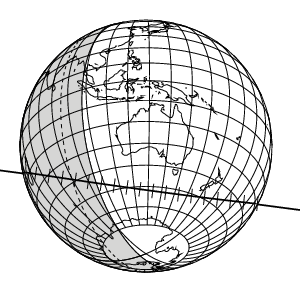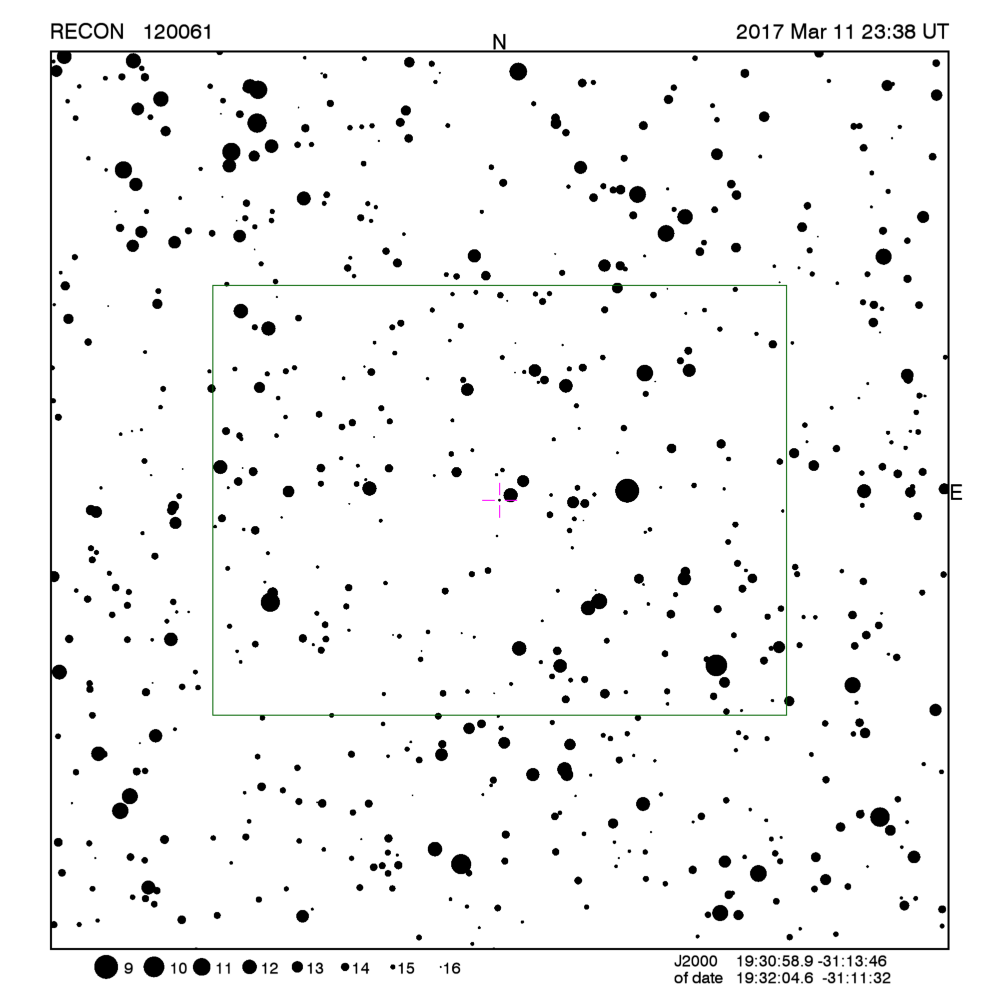RECON: TNO occultation with 120061
Event between (120061) 03CO1 and star UC4-294-217214
with event index number of 21110
Geocentric closest approach at 2017/03/11 23:38:02 UTC
J2000 position of star is 19:30:58.9 -31:13:46
Equinox of date position of star is 19:32:03.7 -31:11:34
Stellar brightness R=16.3
Star is 125 degrees from the moon.
Moon is 100% illuminated.
TNO apparent brightness V=21.4
 TNO is 16.5 AU from the Sun
and 17.0 AU from the Earth.
TNO is 16.5 AU from the Sun
and 17.0 AU from the Earth.
The TNO is moving 22.2
km/sec on the sky relative to the star, or,
6.5 arcsec/hr.
The 1-sigma error in the time of the event is 396 seconds.
The 1-sigma cross-track error in the shadow position is
2247 km.
The TNO has an absolute magnitude Hv=8.9
Diameter=100.0 km assuming a 5% albedo -- 4.5 sec chord
Diameter=40.8 km assuming a 30% albedo -- 1.8 sec chord
Dynamical classification is CENTAURR
Star training set for 120061, (2017/03/11 23:38UT)
Object RA Dec mag sep mel
Antares 16:30:27.9 -26:28:07 0.9 39.78 86
38Zet Sgr 19:03:42.2 -29:51:15 2.7 6.25 120
PPM 299094 19:33:34.0 -30:49:55 6.3 0.48 126
PPM 299090 19:33:21.4 -31:02:17 8.0 0.31 126
PPM 299077 19:32:22.3 -31:11:15 9.2 0.06 125
120061 19:32:04.6 -31:11:32 16.3 125
Positions are for equinox of date

Azimuth is measured in degrees eastward from north.
North is at an azimuth of 0, due East is at an azimuth
of 90 degrees, due South is 180, and due West is 270.
Do not use the listing below for the RECON CPC 1100 telescopes.
This is provided for other non-team facilities.
Star training set for 120061, (2017/03/11 23:38UT)
Object RA Dec mag sep mel
Antares 16:29:24.4 -26:25:55 0.9 39.78 86
38Zet Sgr 19:02:36.7 -29:52:49 2.7 6.25 120
PPM 299094 19:32:28.5 -30:52:11 6.3 0.48 126
PPM 299090 19:32:15.8 -31:04:32 8.0 0.31 126
PPM 299077 19:31:16.6 -31:13:29 9.2 0.06 125
120061 19:30:58.9 -31:13:46 16.3 125
Positions are for J2000
Event circumstances last updated at 2016/12/09 18:46:52 UT
Marc W. Buie,
Southwest Research Institute
RECON
 TNO is 16.5 AU from the Sun
and 17.0 AU from the Earth.
TNO is 16.5 AU from the Sun
and 17.0 AU from the Earth.
